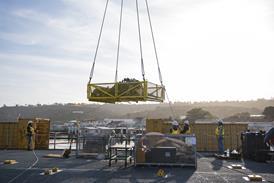Andrzej Jeziorski/TOKYO

Springtime in Japan is traditionally marked not only by the flowering of cherry blossom, but by the stirrings of industrial unrest. This year's strike season, known locally as "shunto", should be well under way, yet the trade unions are more subdued than usual - and nowhere more so than in the airline sector.
In this recession-hit country, poor airline earnings estimates, cancelled aircraft orders and planned route and job cuts have combined to convey the impression of an industry in crisis. Given Japan's tradition of a job for life, people are uncommonly worried about their careers.
"So far we have managed to convince our unions that we are doing the right thing, "says Japan Airlines (JAL), the largest of the country's carriers, where a threatened one-day strike by cockpit and cabin crew recently evaporated.
All Nippon Airlines (ANA) has also managed to keep the unions calm, although Japan Air System (JAS) suffered a round of strikes in mid-April on the Osaka-Guangzhou-Hong Kong and Tokyo-Seoul routes. The protest concerned January's 3% pay cut for cockpit crew, to be followed in April 2001 by further cuts of 12%. Yet even here, normal operations were maintained.
Staff are clearly aware that the last fiscal year has been no easy ride for the airlines, with the downward pressure on yields such that cost-cutting measures have been barely able to keep pace.
The position of Japan's majors has been further undermined by the challenge from two new, low-cost domestic carriers, Skymark Airlines and Air Do, which began competing on the busy Tokyo-Fukuoka and Tokyo-Sapporo routes just as the economic downturn began to bite.
The majors have responded by slashing fares by up to 50%, forcing Air Do's load factor down to 65% by early April from 82%-plus during the first three months of this year. Skymark chairman, Hideo Sawada, has warned that the carrier might have to raise fares from July because of a similar trend.
The start-ups seem about to come under further pressure as JAL and ANA lose patience. The latter undertakes heavy maintenance for Skymark, while Air Do has a similar deal with JAL, but both majors warn they may no longer be able to meet the newcomers' needs if fleets are expanded further.
"The airlines are saying 'that's enough'," says JAL. "On the one hand [the new carriers] are relying on us, yet they are attacking us for dropping our fares to compete."
The impact of the fares war is reflected in ANA's revision of financial estimates for the year ended 31 March, from a loss of ´5 billion ($42.3 million) - expected because of the economic slump and representing the carrier's first operating loss in 19 years - to one of ´11 billion. The revision is blamed mainly on "new entrants in the market".
For its part, JAL has revised its FY1998 net profit forecast upwards from ´10 billion to ´26 billion. The improvement is attributed to ´8 billion from aircraft sales and ´7 billion in aircraft purchase credits (doubling ordinary profit estimates to ´32 billion). JAL's operating profit forecast remains unchanged at ´24 billion. Moreover, a fall in turnover - from ´1.169 trillion to ´1.157 trillion - is still expected.
JAS predicts a profit of about ´200 million for the fiscal year, after losses in three of the past five years, including a ´1.5 billion loss in FY1997-8. All three carriers release their FY1998-9 results at the end of May.
JAL and ANA recently revised their corporate plans for the period to April 2002, with the focus firmly on cost reduction. JAL's is more detailed, featuring 12 aircraft deferrals, a 10% workforce cut and a reduction from 28 directors to 11.
Eight Boeing 777 deliveries are to be deferred, along with three Boeing 767s and one 737. Three Boeing 747 Classics will be retired early, leaving JAL with 151 aircraft by 2002. The move will reduce the airline's interest-bearing debt by ´100 billion to ´1.4 trillion.
In a more radical move, JAL will also transfer some routes to low-cost subsidiary Japan Air Charter (JAZ), which will be renamed - possibly as "JALways" - and relaunched as a scheduled carrier, with a fleet increased to 14 aircraft by 2001.
JAZ operates JAL services on a wet-lease basis and is expected to take over flights to South-East Asia, Oceania and Pacific resorts, with its parent sharing codes.
JAL is also planning to expand the network of domestic subsidiary JAL Express (JEX), which enjoys operating costs 20% lower than the major. JEX may receive additional 737-400s and its first 767s, with these and the JAZ aircraft transferred from JAL's inventory.
The major will concentrate on routes across the Pacific and to Europe and China. Under the new plan it would hope to generate annual ordinary profits of ´30 billion up to and including FY2001, with capacity growing at 2% a year in terms of available seat kilometres, with 3% a year growth in available tonne kilometres.
ANA's new business plan is likely to be confirmed in May, with the airline planning to suspend five international and three domestic routes, and to decrease frequencies on a similar number of services.
Twenty domestic routes will be transferred to ANA subsidiary Air Nippon (ANK). Katsuya Kato, the major's senior manager for strategic corporate planning , says some of these services are operated with load factors of under 50% by 767s, and will be better served by ANK 737s or Airbus A320s.
While ANA's fleet revisions are still to be finalised, Kato says it, too, aims to cut interest-bearing debt by ´100 billion over three years, to ´930 billion.
JAL's announced restructuring saw its share price leapfrog ANA's for the first time in eight years, although ANA is expecting a boost from joining the Star Alliance in October, and predicts a ´8-10 billion increase in revenues over the first year of membership.
Source: Flight International























